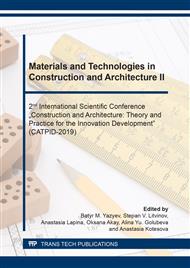[1]
I.Palomar, G.Barluenga, A multiscale model for pervious lime-cement mortar with perlite and cellulose fibers, Construction and Building Materials. 160 (2018) 136-144.
DOI: 10.1016/j.conbuildmat.2017.11.032
Google Scholar
[2]
M.Cachova, D. Konakova, E.Vejmelkova, M.Vysvaril, Ternary binder based plasters with improved thermal insulating ability, 3rd International Conference on Innovative Materials, Structures and Technologies (IMST 2017) 251.
Google Scholar
[3]
Y.Govaertsa, R.Hayenb, M.Bouwc, A.Verdoncka, W.Meulebroeck, S.Mertens, Y.Gregoire, Performance of a lime-based insulating render for heritage buildings, Construction and Building Materials. 159 (2018) 136-144.
DOI: 10.1016/j.conbuildmat.2017.10.115
Google Scholar
[4]
I.Palomar, G.Barluenga, J.Puentes, Lime–cement mortars for coating with improved thermal and acoustic performance, Construction and Building Materials. 75 (2015) 306-314.
DOI: 10.1016/j.conbuildmat.2014.11.012
Google Scholar
[5]
F.Koksala, O.Gencelb, M.Kayac, Combined effect of silica fume and expanded vermiculite on properties of lightweight mortars at ambient and elevated temperatures, Construction and Building Materials. 88 ( 2015) 175-187.
DOI: 10.1016/j.conbuildmat.2015.04.021
Google Scholar
[6]
H. Shoukrya, M.Kotkatab, S.Abo-EL-Eneinc, M.Morsya, S.Shebla, Enhanced physical, mechanical and microstructural properties of lightweight vermiculite cement composites modified with nano metakaolin, Construction and Building Materials. 112 (2016) 276-283.
DOI: 10.1016/j.conbuildmat.2016.02.209
Google Scholar
[7]
V.S. Semenov, D.V. Oreshkin, T.A. Rozovskaya, Light-weight masonry mortars with hollow glass microspheres for winter conditions, Applied Mechanics and Materials. 467 (2014) 247-252.
DOI: 10.4028/www.scientific.net/amm.467.247
Google Scholar
[8]
J.P. Chen, Experimental Study of External Thermal Insulation Mortar Based on Fly Ash Floating Bead, Advanced Materials Research. 476-478 (2012) 1643-1646.
DOI: 10.4028/www.scientific.net/amr.476-478.1643
Google Scholar
[9]
D.Konakova, M.Cachova, E.Vejmelkova, M.Keppert, M.Jerman, P.Bayer, P.Rovnanikova, R.Cerny, Lime-based plasters with combined expanded clay-silica aggregate: Microstructure, texture and engineering properties, Cement and Concrete Composites. 83 (2017) 374-383.
DOI: 10.1016/j.cemconcomp.2017.08.005
Google Scholar
[10]
P.Cachim, A.Velosa, F.Rocha, Effect of Portuguese metakaolin on hydraulic lime concrete using different curing conditions, Construction and Building Materials. 24 (2010) 71-78.
DOI: 10.1016/j.conbuildmat.2009.08.010
Google Scholar
[11]
V.S. Lesovik, I.L. Chulkova, L.K. Zagordnyuk, A.A. Volodchenko, D.Yu.Popov, The Role of the Law of Affinity Structures in the Construction Material Science by Performance of the Restoration Works, Research Journal of Applied Sciences. 9 (12) (2014) 1100-1105.
Google Scholar
[12]
V.I. Loganina, M.V. Frolov, Yu.P.Skachkov, Lime composition for the walls of buildings made of aerated concrete, International Symposium on Mechanical Engineering and Material Science. 93 (2016) 165-169.
DOI: 10.2991/ismems-16.2016.29
Google Scholar
[13]
V.I. Loganina, S.N. Kislitsyna, M.V. Frolov, Addition on the Basis of Mix of the Synthesized Hydrosilicates of Calcium and Aluminosilikates for Dry Building Mixtures, International Conference on Industrial Engineering, ICIE 2016. Procedia Engineering. 150 (2016) 1627-1630.
DOI: 10.1016/j.proeng.2016.07.141
Google Scholar
[14]
V.I. Loganina, M.V. Frolov, Yu.P.Skachkov, Substantion of selection of componets at creation of thermal insulating dry building mixtures, International Journal of Engineering and Technology. 7 (4) 2018 4341-4344.
Google Scholar
[15]
V.I. Loganina, M.V. Frolov, N.I. Makridin, Thermal Insulation Lime Compounds for Walls of Aerated Concrete, International Journal of Applied Engineering Research. 11 (18) (2016) 9443-9445.
DOI: 10.21506/j.ponte.2017.4.29
Google Scholar


